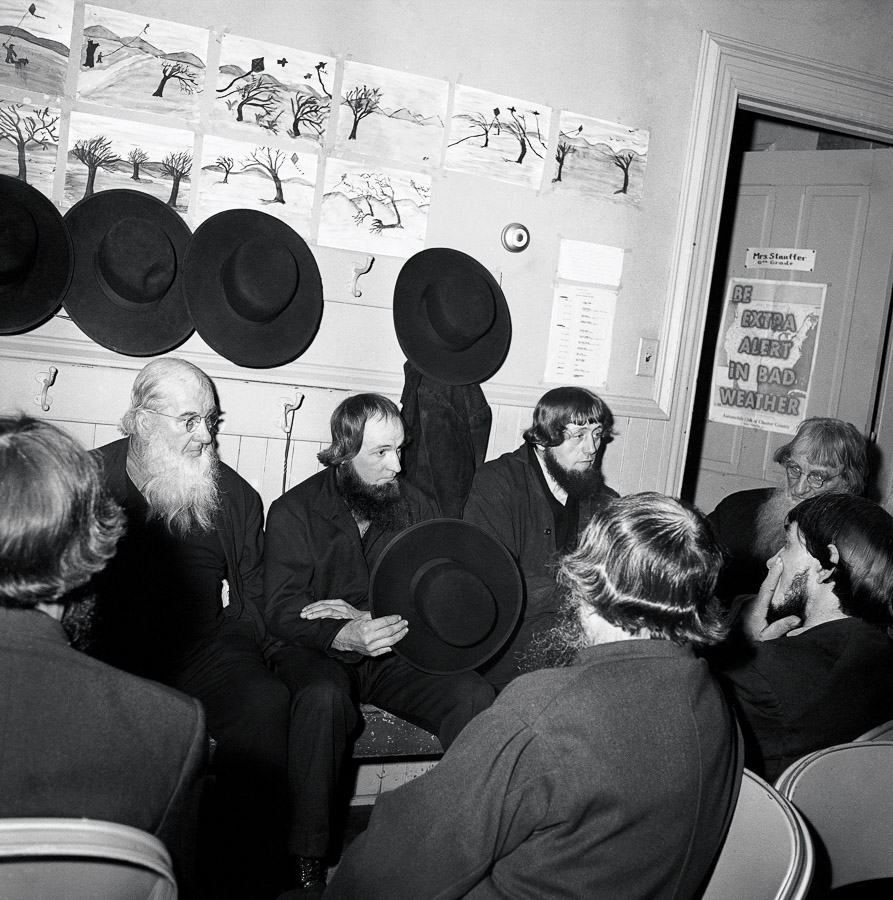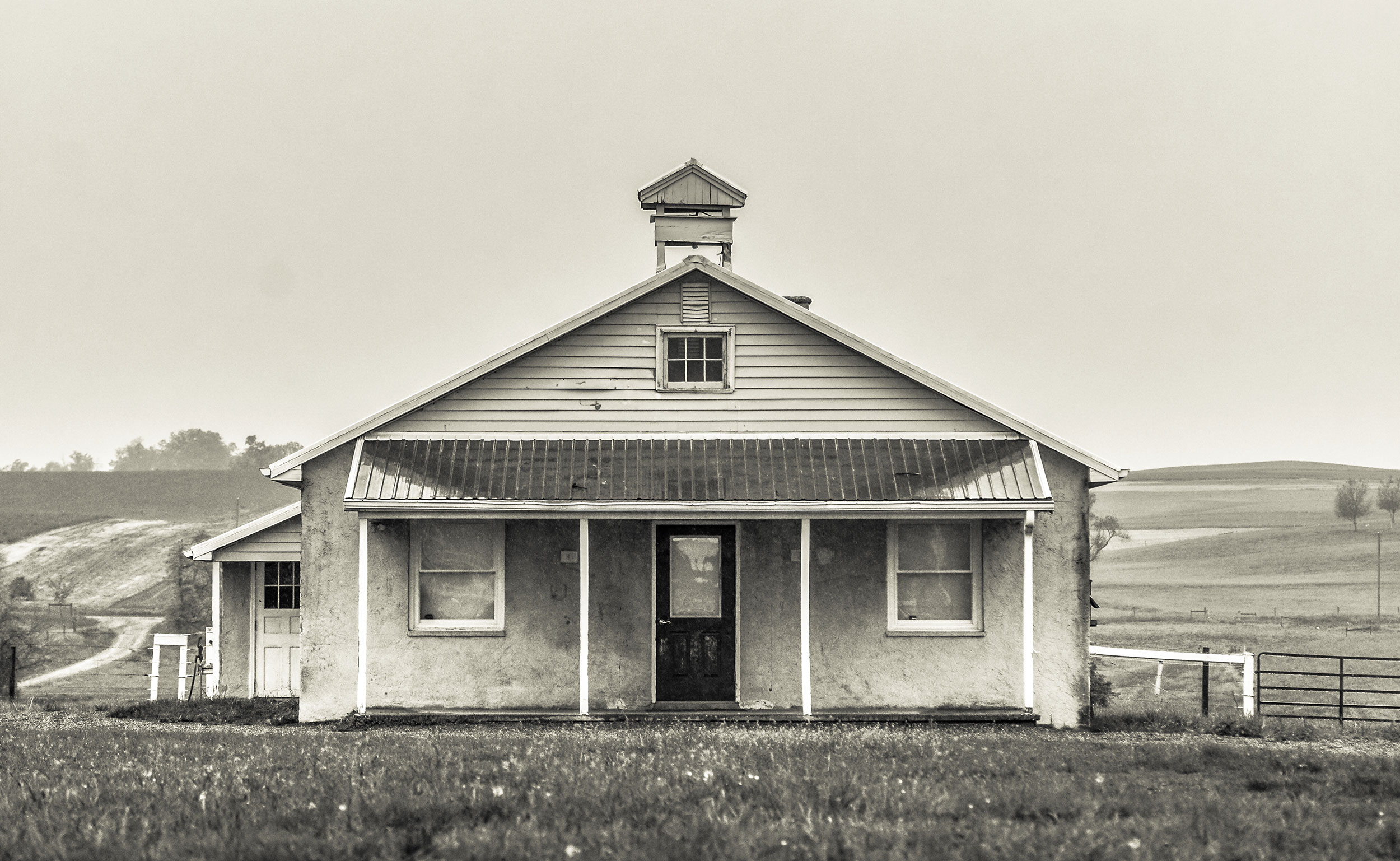words by: Elam Stoltzfus
___________
Part One
___________
“City Lawyer Pops up at Hearing, Offers Amish Surprise Legal Crutch – “13 Fathers Charged With School Law Violations – NOT GUILTY PLEA IS ENTERED”.
This was the headline news for the Wednesday edition of the Pottstown Mercury on February 24th, 1960.
The article goes on to say that, “The 13 Amish fathers are charged with violating the State compulsory school attendance laws because they will not send their 17 children to the multi-million dollar Twin Valley Joint Junior-Senior High School.”
I was only 3 years old when this news came out, and I didn’t remember it at all. But the refusal of the Amish parents to send their children to the new consolidated school would end up influencing my journey through the school system, as well. As I was doing research for these articles, I came across a photo of these Amish fathers from my home church: I knew all of them! And that’s when I realized that my own educational journey was tied up in their story, as well.
My first four years of education (1963-1967) I attended public school in West Nantmeal Township in Chester County, Pennsylvania. By 1967, there was an Amish parochial school for 1st to 8th graders nearby where I lived. My next four years of schooling (1967-1971), I attended the Amish Parochial Fairview school in Honey Brook, Pennsylvania.
I can still remember my first day of school as a first grader: it was the day after Labor Day, and I woke up that morning looking forward to what this new adventure of schooling would bring.
The barnyard rooster crowed at the break of dawn, reminding my family that we had chores to be completed before breakfast. For me, it was feeding a few calves with a bottle of mixed powdered supplement milk. But I wasn’t thinking about calf-feeding—I was thinking about the new adventure of being a first grader: what new people would I meet? What would school be like? I was filled with excitement and trepidation.
After our chores, we seven children sat down to a hearty homemade meal of scrapple, toast, eggs, oatmeal and fruit. After breakfast, I changed out of my dirty work clothes into my clean and pressed school clothes: black pants with a solid-color shirt and white suspenders.
During the busy hustle of getting cleaned and ready, mom packed four lunch meals for those of us who were school-aged. Mom packed a homemade peanut butter and jelly sandwich, fruit, and crackers in my shiny new metal lunchbox. I loved my new lunchbox—it was in the shape of a barn, painted red, and inside was a thermos shaped like a silo. But instead of corn in my silo-thermos, Mom filled it with juice.
Swinging my new lunchbox back and forth as I followed behind my three older sisters, we all stopped at the end of the driveway to wait for the big yellow school bus coming down the hill on Yoder Road.

Back in the 1960s, West Nantmeal primary schools (first to seventh grade) was a collection of one or two room buildings spread across the district, so my sisters and I did not attend the same school. My older sisters attended a two-room schoolhouse in Elverson for 5th and 6th graders, the sister just older than me attended 3rd grade at Franklin School, and I attended 1st grade at Central School, which was a two-room schoolhouse for 1st and 2nd graders.
Central School was a stately white building perched up on the hill overlooking Route 82, and it was only a few miles away from where I lived. I had the best view that Monday morning, as we first graders had class upstairs. I looked around at my fellow classmates—all of them were non-Amish, except for my cousin Melvin Zook. As I found out later, my classmates came from a variety of religious backgrounds: Catholic, Lutheran, Methodist, Greek Orthodox, Mennonite, and Amish.
My first day of school I was nervous, as I didn’t speak English well at all. Cousin Melvin sat behind me and acted as my translator. As Miss Ruth Ann Weiler shared her lesson, Melvin translated her words from English to Dutch. My nervousness soon wore off at recess, where language is no barrier to fun: we laughed and carried on as we played dodgeball, tag, ring-around-the-rosie, and spun to our heart’s content on that wonderful spinning merry-go-round.
It was during my time as a first grader that I met a teacher who changed my life forever. Once a week, we had an art teacher who came to the school to teach us the fundamentals of art. He taught us the primary colors, we did finger paintings, and he taught us how to sketch. During his class time, my imagination was caught up in creating and making things. I’ll never forget when Mister Jere Brady picked up a blank piece of paper and a pencil and sketched out the very schoolhouse where we were sitting! In that moment, I decided that I wanted to become an artist.
There are similarities to my first-grade experience to the way that Amish parochial schools are today: the school was close to where I lived, the classes were small, and we had one primary teacher.
For the Amish leaders in the Twin Valley school district in 1960, the new consolidated school was a bridge too far. As quoted in the Pottstown Mercury, “The Amish, all farmers, will not send their children 10 miles “over the mountains” from Honey Brook to Morgantown, because the Twin Valley school is, “too worldly and too distracting”.
Several Amish families had started a farmhouse school for some of the 8th grade students. The fear among Twin Valley School Board was that the Amish non-attendance would spread, so the school board brought the Amish fathers to court. A series of fines were levied against them until their students attended the new large modern complex, Twin Valley School Joint Junior-Senior High School. The Amish refused to pay the fines. The Mercury explained why they gave this response:
“These people say their religion is older than their government and they will refuse to pay a nominal fine if they are convicted of breaking the school law. Instead, they will go to jail.”

Amish gather in a school room in Honey Brook, Pennsylvania on Feb. 23, 1960, for hearing for 13 fathers charged with violating Pennsylvania’s compulsory attendance law by refusing to send their 17 children to new two-million Twin Valley High School because it’s too distracting. (AP Photo/Sam Myers)
The Superintendent and school officials from Twin Valley decided to prosecute the 13 Amish fathers for their children’s non-attendance at the new Twin Valley School. These Amish fathers were violating the state’s compulsory education code, administrators argued. The Amish refused to change their stance.
“Aaron Beiler, (spokesperson for the group) said they were prepared to go to jail if need be… NONE of the children will go to the Twin Valley school…, however. The Amish intention is that none of them will ever go to the school…Beiler is satisfied with the education the seventh and eighth graders are receiving in a Honey Brook farmhouse – a half day a week under an Amish woman teacher.”
On February 23rd, after several lengthy discussions with the Amish fathers, a New York City attorney representing the Amish, the judge, and the Twin Valley school officials asked the court to adjourn the hearing until a later date. They all agreed that the issue was more complex, and they needed more time to figure things out. The judge announced that, “…this hearing is continued, and will adjourn until March 1 at 7:30.”
Upon hearing the news that the trial would continue on for another week, the group of Amish fathers gathered in a semicircle, huddled together quietly and prayed. While there was pause in the hearings, no one was sure what the ruling of the courts decision would be.
The article for the Mercury concludes with the following line showing how dire the situation was: “If no solution can be reached, the Amish have even considered leaving the twin valleys of the Brandywine and Conestoga rivers – the fertile farmland that [have] been their home since 1717.” (emphasis mine) //

_______________
In Part 2, we will find out what happened a week later in the Twin Valley school district.
_______________
Elam Stoltzfus is a guest writer for Plain Values, and he currently serves as caretaker of the Nicholas Stoltzfus Homestead. In 2016, he documented the Great Florida Cattle Drive, a historic cattle drive telling the story of Florida cowboys. To get a copy of the coffee table book featuring his photos, mail a $35.00 check to: Elam Stoltzfus, 1700 Tulpehocken Road, Wyomissing, PA 19609.




